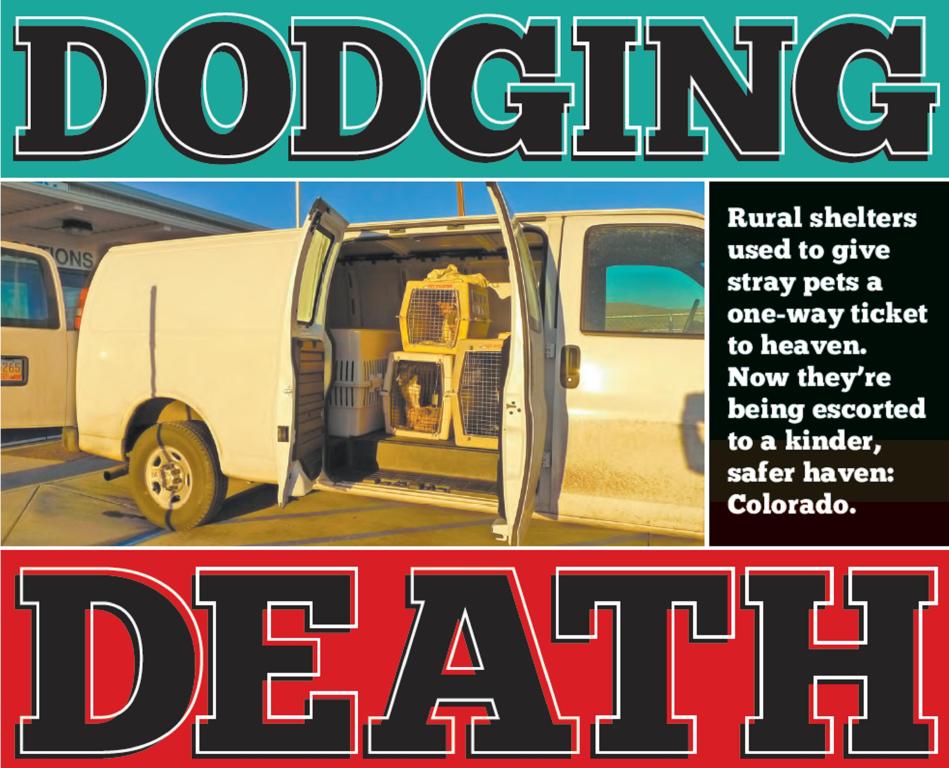VALENCIA COUNTY has possibly the worst reputation in New Mexico for animal cruelty and death by euthanasia. In some years, as many as 95 percent of the dogs and cats that came through its shelter doors left on the end of a needle—and chances are it was Erik Tanner who ordered the execution.
But things have changed in Los Lunas lately, and on a typical spring morning before dawn, the lanky director of the beleaguered county shelter is cheerfully loading a van full of dogs escaping across the border for adoption in Denver.
Victor Galvan will do the driving, as he has done twice a week since last May, barreling as far as Salt Lake City sometimes with crates stacked to the ceiling full of mamas and puppies—more than 100 on a recent trip. Trying not to stop and wake the dogs, he drives like hell for the meeting point where eight to ten rescue groups wait to whisk the dogs to adoption events in Utah, Montana, and Idaho.
Galvan makes $9 an hour for his trouble, though he does get to spend the night in a motel if he goes as far as Utah. Six years ago, when volunteer Patty Mugan took it upon herself to transport dogs on her own, there was no money for motels, and she would turn around in snowstorms and drive the eight hours back from Denver.
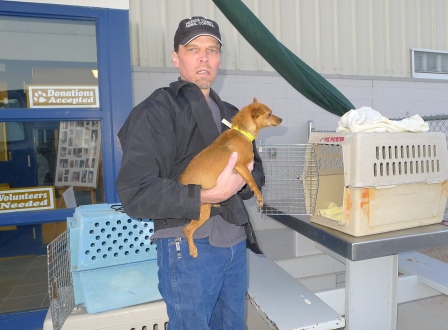
“This place was a kill zone,” admits Tanner, who reports the shelter’s
euthanasia rate is down to a best-ever 41 percent this year, including
nearly all adoptable dogs, thanks to the transports set up by Mugan—whom
he hired and put in charge of adoptions in 2008. A similar change has
been taking place across rural New Mexico, where kill rates of 50 to 85
percent have long been the norm. Where communities are making a dent in
those numbers, transports (or “relocations”) are the main reason.
Devastated by what she discovered at the Valencia shelter, where up to
70 animals are surrendered in a day, Mugan went from being a volunteer
dog walker to dialing desperately for solutions. It was Natalie Owings
of Heart and Soul Animal Sanctuary
in Glorieta who advised her to try getting animals out of New Mexico.
“I started laughing,” Mugan recalls. “I said, we can’t even place them
here. Why would I send them up there?”
Last year, Mugan worked nonstop arranging the transport of 2,200 dogs
out of Valencia County to homes up north, a phenomenon that is happening
everywhere that rescue workers are stepping in to help overburdened
municipal shelters. In Las Vegas, N.M., Martina Holguin moved 900
puppies to Denver last year. Even in the high-kill zone of southeastern
New Mexico, a rescue group is moving puppies from Hobbs to Boulder every
month on the PetSmart Rescue Waggin’.
Certainly, the rise of the Internet and social media has a lot to do
with the relocation phenomenon. Also, well-publicized animal sanctuaries
like Best Friends in Utah and North Shore in New York have long attracted inquiries from across the country for animals whose options run out.
But it was really Hurricane Katrina in 2005 that laid down a network
of drivers and routes, according to Sandy Monterose of the national
ASPCA. Rescue workers loaded up their vehicles nonstop to get animals
out of the disaster zone. Those networks continue to be used, inspiring
the ASPCA leadership to launch a nationwide Web-based mapping service
last June to help make it official. The MAP (Moving Animals Places)
program at ASPCAPro.org allows qualifying rescue groups to input and
share their information on a map, indicating whether they have or need
space for homeless animals.
Where all roads lead
Part of the impetus for the program came out of a workshop that the ASPCA
hosted in New Mexico in 2011, says Monterose, who is senior director of
community initiatives. At one point, rescue groups drew lines on a map
to show where animals were being sent, and all lines seemed to lead to
Colorado. “It was an ‘A-ha’ moment, where everyone said, Look at that!”
Monterose said. “But you couldn’t have that knowledge until you put the
dots on the map.”
The challenge now, she said, is to reach hundreds of shelters and
rescue groups across the nation and get them plugged into the map so
transport can happen more effectively.
Meanwhile, informal networks have sprung up spontaneously on email lists and social media, such as the Animal Rescue Transport Network, Animal Transport Resources, and Shelter Transport Animal Rescue Team (START)
on Facebook. “I can’t imagine doing rescue without Facebook,” says
Holguin of Las Vegas, who used to fi nd adoptive homes by working the
phones. For about a decade, private pilots have helped transport animals
cross-country through organizations such as Pilots N Paws Rescue, Flying Paws, Air Angels, and Animal Rescue Flights. Long-haul truckers have stepped in with Operation Roger and Heart’s Hope, which carry animals on routes they’re already driving.
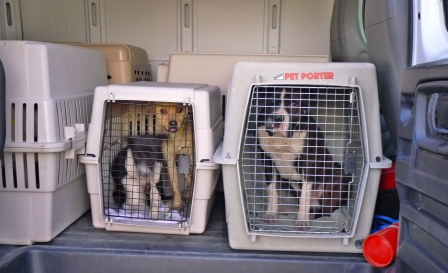
Of course, not all transport happens well or legitimately, which is
one reason the ASPCA includes peer reviews in its network. Locally, the
group Animal Protection of New Mexico is working to set basic standards
for transport, coordinating with the ASPCA to establish “best practices”
that lessen stress and risk on animals and drivers.
Leslie King, APNM program director, said the group counted roughly
10,000 dogs and 900 cats transported in New Mexico in 2012—a 73 percent
increase from 2009—most of them headed north to Colorado, Utah,
Washington, Oregon, and Idaho. The northward trend holds nationally as
well, with animals on the East Coast moving from the southern states to
New England, though there are also destinations in Florida.
“Economics and population density are factors,” explained the ASPCA’s
Monterose, “but it’s also climate, attitudes toward pet ownership, and
affordability and accessibility of spay/neuter.”
The reason is legal
New
Mexico rescue workers will tell you the main reason Colorado and
Washington can take so many homeless animals is because they have
successfully limited their own.“In the Denver area, they’ve had over ten
years of enforced spay/neuter, so they don’t have the overpopulation,”
says Holguin. It’s not that wealthier communities make better homes, she
said. “Economics are absolutely a factor, but it isn’t what makes a
good pet guardian. It’s having the laws and the judicial system to
enforce them.”
King agrees. “Spay/neuter has to be the number-one solution” to the
problem of pet overpopulation in New Mexico, she says. “Passing laws is
part of it—but it takes effort and time.”
Mandatory spay/neuter laws have proved difficult to pass here
politically, and APNM doesn’t think they make sense until and unless
spay/neuter is widely available and affordable. But communities are
seeing some success with levying fi nes, requiring litter permits, and
other types of pushback that force pet owners to be more responsible,
and prevent situations like in Valencia County, where the same people
bring a litter of puppies to the shelter every few months. “They tell
me it’s cheaper to dump the dogs at the shelter than to pay for spay,”
Mugan says sadly.
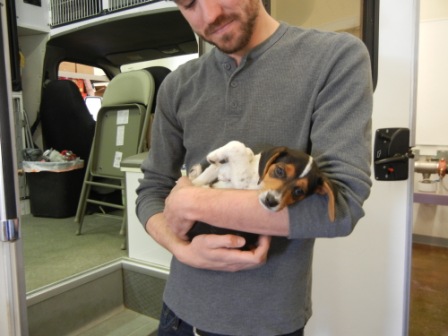
This year for the first time, Albuquerque Animal Welfare started
refusing intakes because the public shelter is full, putting applicants
on a waiting list
and encouraging them to find solutions on their own. “It’s a bold move,
because everyone thought they had to accept anything at any time,” says
Peggy Weigle, executive director of Albuquerque’s largest rescue
organization. Weigle herself set the tone last year by instituting “managed admissions”
at Animal Humane New Mexico, whereby pet owners must make appointments
and meet with a counselor before turning over a pet. “Since neither of
us euthanize for space, the public is being trained,” she says.
Under Weigle’s leadership, Animal Humane has become a model of the
multi-pronged approach needed to attack the crisis of pet
overpopulation. Th e group has used everything from professional
marketing campaigns to animal personality assessments to its recent $5
million state-of-the-art renovation to create optimum conditions for
adoption.
As a result, Animal Humane is one of only two organizations in the
state (along with the Santa Fe Animal Shelter, also recently rebuilt)
that is a destination for transported animals. Thanks to its ability to
get 100 percent of its healthy intakes adopted, according to Weigle,
Animal Humane took in 1,300 animals last year from high-kill shelters
around the state. Its Project Fetch
works with 15 groups in 13 counties on a rotating basis, taking in a
dozen or more animals each week. Once a month, its mobile van goes to
Roswell to load up with 35 to 40 more dogs deemed “highly adoptable,”
and bring them here for adoption.
“The trend is not to take them to the point of being over capacity,”
Weigle says of recent changes in thinking about shelter management.
“Push back on owners to re-home or solve behavioral problems” on their
own, she says. “Because if you drill down, it’s behavior problems that
are behind owner surrenders.”
Of course, such solutions take money, which Animal Humane has been highly successful at raising.
Mission to save lives
Municipal
animal shelters, by contrast, generally cannot refuse intakes, since
their mission is related to public safety. They also cannot solicit
donations or volunteers, the engine of successful rescue. That’s why,
wherever animals are escaping high-kill shelters, it’s because the
shelter has contracted with a nonprofit to take over the business of
saving lives.
In Taos, Espanola, Gallup, Silver City, Ruidoso, Las Vegas, and other
communities, the public shelter has partnered with an established local
rescue group to oversee adoptions and public education programs like
spay/ neuter. Similarly, Erik Tanner was only too happy to turn over
Valencia County adoptions to Patty Mugan, given that the county takes in
7,500 animals a year and has just 76 kennels. He jokes that she has him
driving to Colorado all night, hustling back to the shelter at dawn to
load up another van and hand over his own cash to the driver.
It’s a 180-degree change, in many cases, from the way public shelters
used to treat rescue groups. In the past, some would not even hand over
animals on the kill list, for fear they would end up back at the
shelter—or their puppies would, said Joyce Fay, Bosque Beast columnist
and founder of Bro & Tracy Animal Rescue.
Traveling around the state, Fay has noticed changes lately at rural
shelters that work with rescue groups to institute best practices.
Still, the situation in New Mexico has not really changed, she says.
“The places that are getting better, it’s primarily because they’re
transporting. It’s not because they’re adopting more, not because
they’re doing more spay/ neuter or getting fewer dogs.”
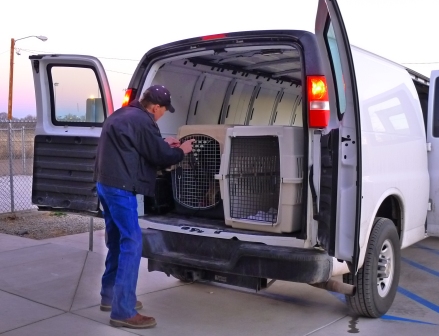
Leslie King confirms this sad truth. Statewide, the number of animals
showing up at shelters remains unchanged, she says, with the euthanasia
rate still around 50 percent. That’s why the ASPCA has targeted New
Mexico, among other states, to focus its efforts (“High-risk breeds get help”).
Shelters here often lack adequate training and funding; many have
cramped, dismal facilities and don’t do enough to keep animals healthy,
King says.
Transport is undoubtedly saving hundreds of lives each month—in
Valencia County, it accounts for 80 to 90 percent of the shelter’s drop
in euthanasia—but moving animals elsewhere is clearly not a long-term
solution. And while donations tend to pour in for transport, rescue
workers say, taxpayers have proved less willing to underwrite it.
Problem is here
“We
don’t want to be pushing our problems onto Colorado because they have
their spay/neuter laws in place,” says King. Transport also fails to
help a large population of homeless animals in New Mexico: Pit Bull
breeds and cats, which are not wanted anywhere.
“Ultimately the problem is here,” agrees Holguin, who returned to the
town where she grew up and realized the animal abuse and cruelty was not
alright with her. Committed rescue workers like Holguin and Mugan have a
boots-on-the-ground view of the long-term need for funding,
legislation, education, and communication. But their energy is exhausted
short-term getting an endless stream of animals on the freedom train up
north.
That’s why, in the predawn darkness in Los Lunas, no one questions
whether it’s worthwhile to spend eight hours on the road fueled on
minimart coffee to deliver one vanload of dogs to safety—when 70 more
will be waiting to enter lockup on Tuesday. It’s like going from the gas
chamber at Auschwitz to writing Schindler’s List; like whisking slaves
from your attic to the underground railroad, seeing even one litter of
innocent puppies escape the pitiless fate created by humans.
It’s angelic. It’s exhilarating. And Victor Galvan’s look will tell you, it’s worth $9 an hour.
Help get things moving
The ASPCA’s online resource Moving Animals Places is free to animal welfare groups, shelters, veterinarians, law
enforcement and emergency responders seeking to connect to transport networks nationwide: aspcapro.org/map
PetSmart Charities operates a rescue waggin’ transport service. Apply online at petsmartcharities.org/pro/adoption-programs/rescue-waggin.
Animal Protection New Mexico is a great resource for rescue groups and shelters seeking information on
resources statewide. Their directory of low-cost and free spay/neuter resources is at www.apnm.org/campaigns/animal_overpopulation/spay_neuter_resources.php
To learn about their animal Shelter assistance Program: apnm.org/programs/shelter_support/
The Valencia County Animal Shelter seeks homes around Albuquerque to briefly shelter dogs awaiting transport, to free up space at the overcrowded shelter. Contact foster coordinator Marie Privett at 715-9116 or bridgestohome@gmail.com, or transfer coordinator Patty Mugan at 401-0371 or pattymugan@aol.com.

